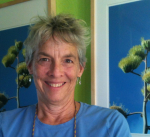Simplicity and Dyeing
 Thursday, March 1, 2007 at 07:55AM
Thursday, March 1, 2007 at 07:55AM A bit more on the dye ceremony: Pat Schulz, another artist among those present, shared her pictures of the final "product," a unique silk scarf with ruffled edges, due to the two different weaves in the silk. First, the scarf being dyed (before the mordant of iron).

The simplicity of the ceremony and the beauty of the scarves came to mind with a bit of synchronicity in my reading last night of John Maeda's The Laws of Simplicity. Maeda, a graphic designer, visual artist and computer scientist, is the founder of the SIMPLICITY Constortium at the MIT Media Lab (where he is a professor). He writes in Law 7 (Emotions: More emotions are better than less):
"Growing up, my siblings and were taught that everything in our environment, including inanimate objects, had a living spirit that deserved respect." 'Even a cup?' we asked. 'Even a desk?'...The answer was always, 'Yes.'....Believing that all things around you -- rocks, river, mountain and clouds -- are somehow 'alive' was something that I couldn't grasp as a child. However, as an adult, I prefer the world with its mysteries intact and I find myself comfortable with the thought....
And he goes on to explain:
"Aichaku (ahy-chaw-koo) is the Japanese term for the sense of attachment one can feel for an artifact. When written by its two kanji characters, you can see that the first character means 'love' and the second one means 'fit.' "Love-fit' describes a deeper kind of emotional attachment that a person can feel for an object. ... Acknowledging the existence of aichaku in our build environment helps us to design artifacts that people will feel for, care for and own for a lifetime."
In the midst of our disposable culture, a consumerism run rampant, we as artists and as owners of "stuff" could perhaps think a bit more about aichaku.






Reader Comments (1)